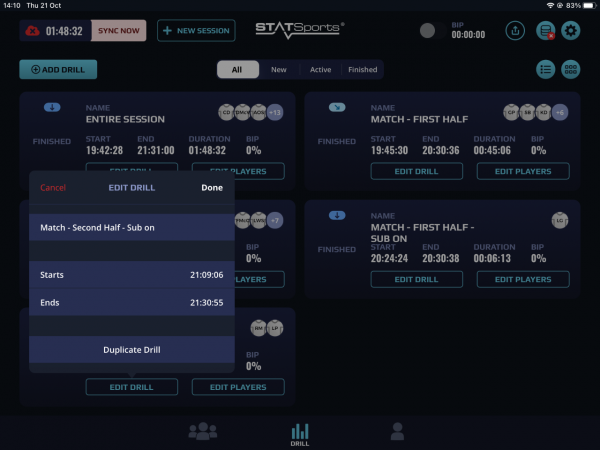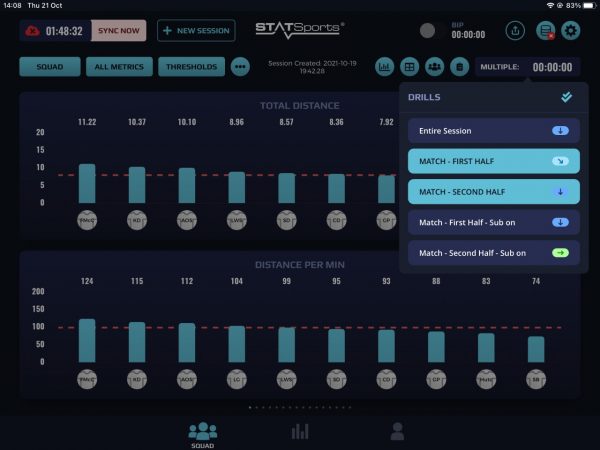
09 Jun Seamless Drill Duplication & Accumulation with Sonra Live
INTRODUCTION
Sonra Live allows users to create up to 100 drills in real time or in advance of a drill commencing, and the with drill duplication and accumulation features this further helps to improve the user workflow on field.
Through the Sonra Live iPad application, users can duplicate drills to reduce the time spent adding a new drill by cloning the drill title, along with retaining the player selection in these original drill.
Multiselecting drills, via drill accumulation, allows the user to view combined drill workloads in a real-time manner, excluding rest periods in between drills.
These rest periods may include walking and low-intensity activity, which may not truly reflect the drill workload and intensity or exertion through per minute metrics (Distance/ HMLD/ HSR per minute).
Utilising Drill Duplication & Accumulation
Before duplicating a drill, a drill must be added by selecting ‘Add Drill’, then choosing a title for the drill and selecting the players in the drill.
To create a duplicate drill, select ‘Edit Drill’ on the chosen drill > select ‘Duplicate Drill’.

Once you have selected duplicate drill, a drill will be created which will retain the players in the original drill and have an identical drill name.
To use the drill accumulation feature, open a drill from the drill dashboard. At the top right of the screen, select the drop-down list of drills.

From here, select the double tick icon at the top right, to allow multi-select. Once multi-select is toggled on, select the drills you would like to accumulate.
PRACTICAL APPLICATIONS
Drill accumulation allows the user to combine the drill totals, in order to gauge total workload. If the user wants to view accumulated drill workload, several drills (max 5) can be selected at once.
In a training session including several blocks of small-sided games, the user can aggregate the total workload and intensity across each block.
Figure 4 displays the Distance per minute and HML Distance per minute for two blocks of an 8v8 small-sided game, for an individual player. The total, which includes the time from the beginning of the first block to the end of the second block, displays an overall reduced intensity.
Using drill accumulation, the user can view an aggregate of the two blocks, to display the actual intensity. This is useful for practitioners who may want to maintain a high intensity across multiple blocks, removing rest periods which can lead to an underestimation of physical demands [1].

The drill accumulation feature could also be used as a method of monitoring internal workload in athletes. Practitioners can accumulate the individual drill workload to find the total time spent in drills, excluding rest periods. This can then be multiplied by session rate of perceived exertion (sRPE) to find the workload, by excluding rest periods [2].
During live sessions, users can easily duplicate drills in order to improve the user workflow between drills.
The feature is particularly useful for users who want to run multiple bouts of small-sided games or conditioning drills, which contain the same players.
On matchday, the user can duplicate their first half drill to create a second half drill, retaining the selected players (and then edit players from the new drill if required).
To distinguish between duplicated drills, the user can then edit the drill name, with the option to add an additional free text.
Combined with the drill labels feature, duplicating drills allow the user to maintain a consistent database of drills by keeping drill title identical to the previous drill, while retaining the players from the original drill, removing the need for the user to select the players again.
References
- Wass, J., Mernagh, D., Pollard, B., Stewart, P., Fox, W., Parmar, N., Jones, B., Kilduff, L. and Turner, A.N. (2020) ‘A Comparison of Match Demands Using Ball-in-play vs. Whole Match Data in Elite Male Youth Soccer Players’ Science and Medicine in Football, 4(2), 142-147
- Wallace, L.K., Slattery, K.M., Impellizzeri, F.M. and Coutts, A.J. (2014) ‘Establishing the Criterion Validity and Reliability of Common Methods for Quantifying Training Load’ The Journal of Strength & Conditioning Research, 28(8), 2330-2337